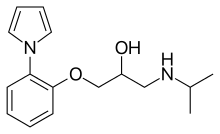Isamoltane
Isamoltane (CGP-361A) is a drug used in scientific research. It acts as an antagonist at the β-adrenergic, 5-HT1A, and 5-HT1B receptors.[1] It has about five times the potency for the 5-HT1B receptor (21 nmol/l) over the 5-HT1A receptor (112 nmol/l).[2] It has anxiolytic effects in rodents.[3]
 | |
| Clinical data | |
|---|---|
| ATC code |
|
| Identifiers | |
IUPAC name
| |
| CAS Number | |
| PubChem CID | |
| ChemSpider | |
| Chemical and physical data | |
| Formula | C16H22N2O2 |
| Molar mass | 274.357 g/mol g·mol−1 |
| 3D model (JSmol) | |
SMILES
| |
References
- Langlois M, Brémont B, Rousselle D, Gaudy F (1993). "Structural analysis by the comparative molecular field analysis method of the affinity of beta-adrenoreceptor blocking agents for 5-HT1A and 5-HT1B receptors". Eur. J. Pharmacol. 244 (1): 77–87. doi:10.1016/0922-4106(93)90061-d. PMID 8093601.
- Rényi L, Larsson LG, Berg S, Svensson BE, Thorell G, Ross SB (1991). "Biochemical and behavioural effects of isamoltane, a beta-adrenoceptor antagonist with affinity for the 5-HT1B receptor of rat brain". Naunyn Schmiedebergs Arch Pharmacol. 343 (1): 1–6. doi:10.1007/bf00180669. PMID 1674359.
- Waldmeier PC, Williams M, Baumann PA, Bischoff S, Sills MA, Neale RF (1988). "Interactions of isamoltane (CGP 361A), an anxiolytic phenoxypropanolamine derivative, with 5-HT1 receptor subtypes in the rat brain". Naunyn Schmiedebergs Arch Pharmacol. 337 (6): 609–620. doi:10.1007/bf00175785. PMID 2905765.
| 5-HT1AR agonists | |
|---|---|
| GABAAR PAMs |
|
| Gabapentinoids (α2δ VDCC blockers) | |
| Antidepressants |
|
| Sympatholytics (Antiadrenergics) |
|
| Others | |
| |
This article is issued from
Wikipedia.
The text is licensed under Creative
Commons - Attribution - Sharealike.
Additional terms may apply for the media files.